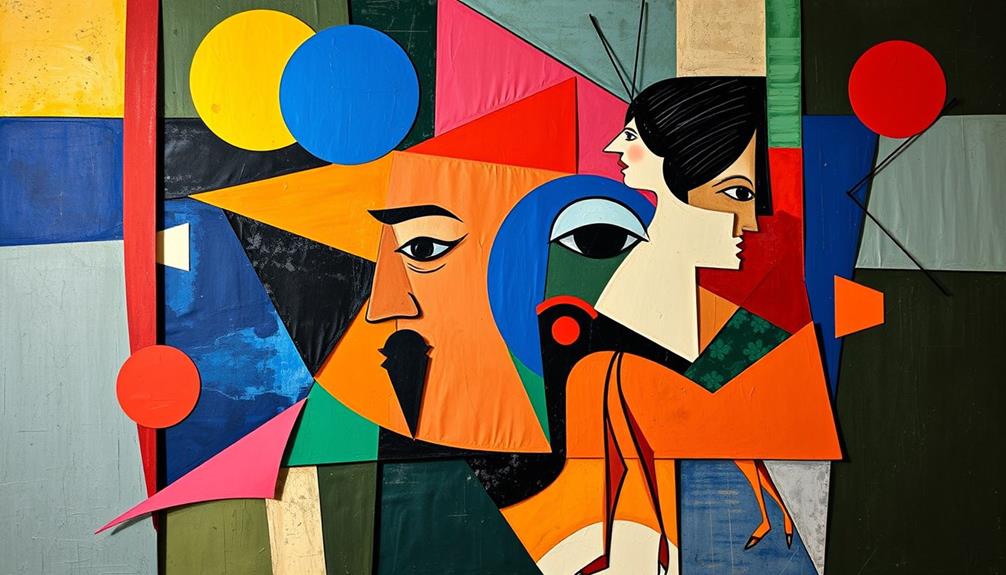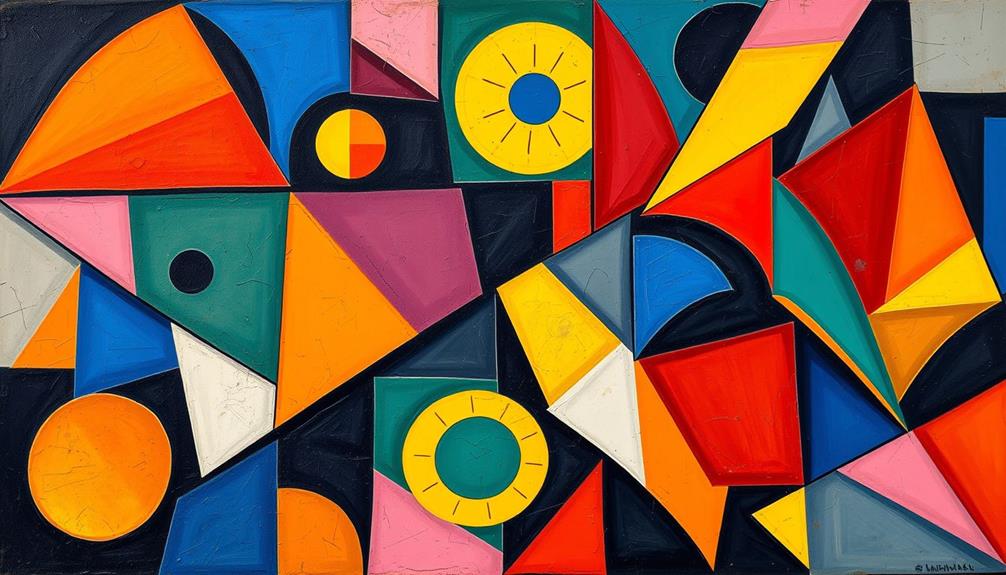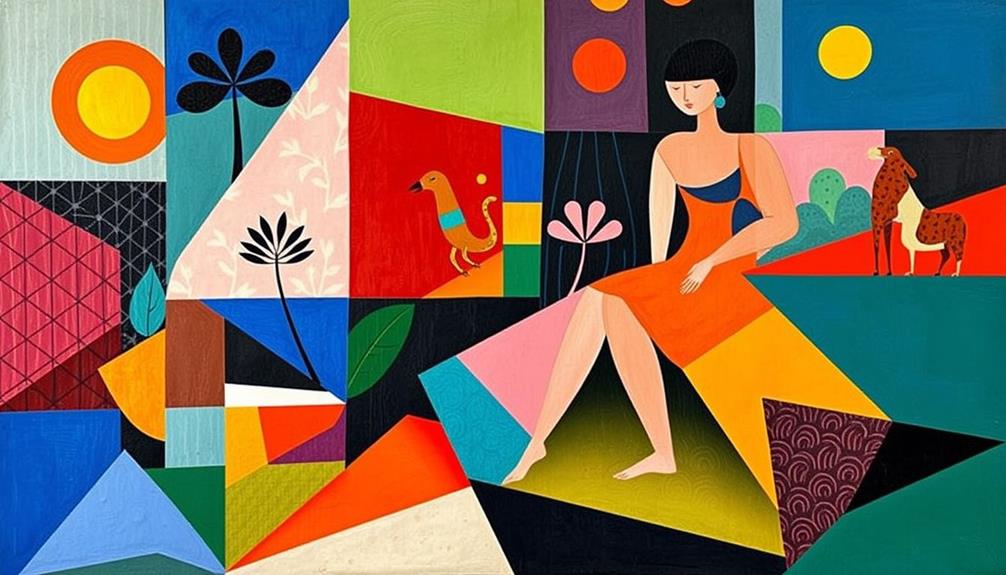Gaganendranath Tagore's Cubist period was a pivotal moment in Indian art. You'll see how he fused traditional Indian themes with innovative Cubist techniques, pushing the boundaries of contemporary expression. His notable works, like "Nandini: Heroine" and "House of Mystery," highlight his unique approach to perspective and spatial values. He became the first major figure in India to embrace Cubism, and his contributions sparked a transformative dialogue within the art community. As you explore further, you'll uncover more about his lasting impact and the cultural significance of his work in shaping modern Indian artistic identity.
Key Takeaways
- Gaganendranath Tagore was the first major proponent of Cubism in India, revolutionizing traditional art practices through modern techniques.
- His key works, like "Nandini: Heroine" and "House of Mystery," showcase the innovative blend of Indian themes with Cubist elements.
- Tagore's experimentation with perspective and overlapping planes marked a significant evolution in Indian art during his Cubist period.
- His contributions were initially overlooked but gained recognition through art historian Stella Kramrisch and significant exhibitions highlighting his unique style.
- Tagore's legacy continues to influence discussions on cultural identity in art, inspiring future generations of Indian artists.
Overview of Gaganendranath Tagore
Gaganendranath Tagore's artistic journey reflects a profound exploration of identity and culture. Born in 1867 into the esteemed Tagore family in Kolkata, he became a pivotal figure in modern Indian art and the Bengal School of Art.
After the tragic loss of his son in 1907, you'll see how he deepened his painting practice, drawing upon diverse influences like Japanese ink wash techniques, Impressionism, and Cubism. His unique ability to merge these styles with Indian themes set him apart, similar to how mushroom coffee provides health benefits by combining various elements for a rich experience.
In 1907, Gaganendranath co-founded the Indian Society of Oriental Art, fostering a space for artistic dialogue and education. By 1915, he established the Bichitra Club, further promoting art and cultural engagement in Indian society.
His first Cubist works emerged in 1922, capturing the attention of art historian Stella Kramrisch, which marked a significant milestone in his contribution to the Indian modernist movement.
Even after a cerebral stroke in 1930 curtailed his artistic output, Gaganendranath Tagore's legacy remains influential, continuing to shape discussions around cultural identity and modern Indian art today.
Influence of Cubism

Cubism had a transformative impact on Gaganendranath Tagore's artistic approach, allowing him to break away from the confines of traditional Indian art. As the earliest proponent of Cubism in India, he integrated its principles into his unique style, setting a precedent for future artists. His first Cubist works, published in the art journal "Rupam" in 1922, garnered attention from art historian Stella Kramrisch, highlighting his innovative contributions to modern art.
This artistic evolution parallels other shifts in various fields, such as how energy-efficient upgrades have transformed pool maintenance practices, emphasizing the importance of adaptation and innovation.
Gaganendranath's experimentation with Cubism enabled him to explore multiple viewpoints and interlocking planes, marking a significant evolution in his artistic expression during the 1920s. Pieces like "Nandini: Heroine" and "Jagadish Chandra Bose Demonstrating his New Apparatus" showcase how he blended Indian cultural elements with modernist techniques.
This fusion not only redefined his work but also influenced the broader landscape of Indian art. The influence of Cubism on Tagore's oeuvre represents a critical shift in how traditional Indian practices intersected with contemporary movements.
Key Works From the Period

As you explore Gaganendranath Tagore's Cubist period, you'll encounter several key works that showcase his innovative techniques.
His unique approach to blending traditional Indian themes with modern artistic styles can be likened to the way certain zodiac signs are associated with higher charisma levels.
Pieces like "House of Mystery" and "Nandini: Heroine" highlight his ability to blend Cubism with Indian themes while experimenting with color and form.
Each masterpiece not only reflects his artistic evolution but also underscores the intersection of cultural identity and modern art.
Notable Cubist Masterpieces
Notable for their innovative fusion of traditional Indian themes and modern techniques, Gaganendranath Tagore's key works from his Cubist period showcase a remarkable evolution in Indian art. His piece "Nandini: Heroine" (1925) exemplifies this innovative approach, merging Indian storytelling with fragmented forms and multiple perspectives characteristic of Cubism.
In his exploration, Tagore also reflects on the contemporary dialogues within art, as seen in the rise of AI-generated music that provokes discussions on creativity and ownership. In "Jagadish Chandra Bose Demonstrating his New Apparatus" (1925), you see Tagore creatively depicting the famed scientist, emphasizing the interplay of light and shadow—a reflection of both modernity and cultural significance.
"House of Mystery," showcased at the Bauhaus exhibition, marks a significant milestone in Indian painting, presenting a complex interplay of shapes that highlight spatial relationships within a Cubist framework.
Meanwhile, the "Himalaya Series" (1910-1921) reveals Tagore's exploration of landscapes through a Cubist lens, capturing the emotional essence of the mountains with overlapping planes and abstract forms.
His artistic contributions culminated in the 1922 publication of works in "Rupam," where he gained recognition from art historian Stella Kramrisch, solidifying his role in advancing modernist movements in India.
Tagore's Cubist works remain a reflection of his pioneering spirit in the art world.
Techniques and Innovations
Art enthusiasts will find Gaganendranath Tagore's techniques and innovations during his Cubist period to be a fascinating blend of traditional Indian aesthetics and modern artistic expressions. His early Cubist works, published in the art journal "Rupam" in 1922, marked his formal recognition as a Cubist artist in India.
Remarkably, "House of Mystery," showcased at the Bauhaus exhibition, exemplifies his innovative use of overlapping planes and fragmented forms characteristic of Cubism. This period of his work resonates with the way artistic journeys explore cultural contexts and creativity.
Tagore's significant pieces, like "Nandini: Heroine" and "Jagadish Chandra Bose Demonstrating his New Apparatus," highlight his unique approach in 1925. He skillfully experimented with perspective and spatial values, infusing Indian painting with a modernist flair.
His darker shades and abstract techniques distinguished him from traditional Indian art, showcasing his ability to convey complex narratives through Cubist forms.
Artistic Techniques and Innovations

During Gaganendranath Tagore's Cubist period, he seamlessly blended Indian cultural elements with modern artistic trends, creating a distinctive style that set him apart from his contemporaries. His innovative approach to Cubism involved several artistic techniques that emphasized abstract forms while retaining ties to Indian culture. This fusion of styles can be likened to the way essential tools for creating music tracks enhance creativity in music production.
Here's what made his work stand out:
- Surface Design: Tagore experimented with textures and patterns, adding a unique layer to his Cubist compositions.
- Use of Light: He skillfully manipulated light and spatial values, enhancing the emotional depth of his pieces.
- Simplicity and Structure: By focusing on essential forms, he created works that were both stark and complex, diverging from traditional Indian art.
Notable examples like "Nandini: Heroine" and "Jagadish Chandra Bose Demonstrating his New Apparatus" showcase these techniques beautifully. Through them, you can see how he combined structure with emotional resonance, allowing viewers to connect deeply with his vision.
Gaganendranath Tagore's commitment to merging artistic techniques from Cubism with the essence of Indian culture led to a pioneering phase that continues to inspire.
Impact on Indian Art

Gaganendranath Tagore's influence on Indian art is profound and far-reaching. As the first major proponent of Cubism in India, he introduced this revolutionary movement during a time of significant artistic transformation in the early 20th century. His early Cubist works, published in the journal "Rupam" in 1922, marked a pivotal moment in the recognition of modern art within the Indian art world.
The integration of AI-driven solutions into contemporary art practices echoes the innovations Tagore championed, showcasing how technology can enhance creativity.
Tagore's innovative use of light, space, and abstraction helped bridge traditional Indian art with Western modernism. His piece, "House of Mystery," showcased at the Bauhaus exhibition, exemplified his unique approach to Cubism, emphasizing overlapping planes and geometric shapes.
This resonated with contemporary artistic movements and demonstrated how Indian artists could embrace new styles while retaining cultural roots.
Reception and Recognition

Often overlooked in discussions of modern Indian art, Gaganendranath Tagore's Cubist works have gained significant recognition over time. Initially published in the journal "Rupam" in 1922, his innovative approach to Cubism caught the attention of art historian Stella Kramrisch, marking him as a key figure in the Indian modernist movement.
Despite this early recognition, Gaganendranath's contributions remained relatively underappreciated compared to his contemporaries. His artistic journey reflects a complex interplay of personal experiences and cultural influences that could be likened to the dynamics seen in narcissistic relationships, where the need for validation plays a pivotal role.
However, his unique blend of Cubism with Indian themes established a distinctive style that bridged Eastern and Western art traditions. The gradual shift in recognition can be attributed to several factors:
- Exhibitions: His works featured in significant showcases, including the Bauhaus exhibition, which highlighted his pioneering role.
- Scholarly Reassessment: Contemporary art scholars are starting to reevaluate his importance, shedding light on his innovative contributions.
- Influence on Future Generations: His distinct style has inspired upcoming artists, emphasizing the relevance of his work in modern art.
Through these efforts, Gaganendranath Tagore's legacy in Cubism continues to gain the recognition it deserves.
Lasting Legacy and Contributions

The recognition Gaganendranath Tagore has begun to receive reflects the lasting impact of his Cubist works on the Indian art scene. As the earliest proponent of Cubism in India, he skillfully blended this modern art movement with traditional Indian themes, creating a unique fusion that resonated deeply with both Eastern and Western audiences.
His innovative perspective can be likened to the fusion of diverse experiences found in reviving old friendships, which also emphasizes the significance of blending different influences. His groundbreaking piece, first published in "Rupam" in 1922, marked a significant milestone in the evolution of Indian art and earned accolades from art historian Stella Kramrisch.
Exhibitions featuring Tagore's Cubist works, like "House of Mystery" showcased at the Bauhaus exhibition, initiated crucial dialogues between differing artistic traditions. His innovative approaches to light, space, and geometric forms not only enhanced the understanding of modernist expressions but also paved the way for future generations of Indian artists.
Through his contributions to Cubism, Gaganendranath Tagore has left a lasting legacy that emphasizes the importance of Indian identity within a global context. His influences and innovations continue to inspire contemporary artists, ensuring that his impact on modern art remains significant and relevant today.
Frequently Asked Questions
Why Is Gaganendranath Tagore Remembered?
You remember Gaganendranath Tagore for his pioneering role in Indian Cubism, blending traditional themes with modern techniques. His unique style and innovative approach greatly shaped the evolution of Indian art, marking a transformative period.
What Are the Characteristics and Style of Painting of Gaganendranath Tagore?
Gaganendranath Tagore's paintings blend fragmented forms with traditional motifs, creating a unique rhythm. You'll notice geometric shapes and a darker palette, emphasizing simplicity and light, capturing both Western influences and Indian essence beautifully.
Who Was Gaganendranath Tagore Brief Biography?
Gaganendranath Tagore, born in 1867, was a self-taught artist who co-founded the Indian Society of Oriental Art. He gained fame for his Cubist works, leaving a lasting impact on Indian art before passing in 1938.
Who Is the Father of Indian Cubism?
You might think Cubism sprang from Western artists, but Gaganendranath Tagore's actually the father of Indian Cubism. His unique blend of traditional Indian elements and Cubist techniques truly transformed the art scene in India.
Conclusion
In exploring Gaganendranath Tagore's cubist period, you see how his innovative spirit and unique influences shaped Indian art. As the saying goes, "Art is the most beautiful of all lies," and Tagore masterfully blended reality with abstraction. His key works and techniques not only pushed boundaries but also paved the way for future artists. By appreciating his contributions, you can truly understand the lasting impact he's had on the art world and the evolution of Indian creativity.









